TT pistol
| TT (Tula Tokarev) | |
|---|---|
box magazine compatible with Zastava M57 | |
| Sights | Front blade, rear notch 156 mm (6.1 in) sight radius |
The TT-30,
Development
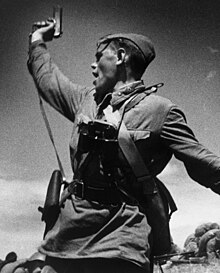
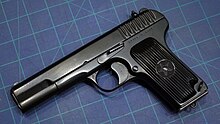
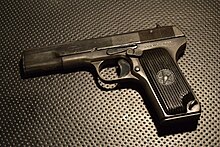
In 1930, the Revolutionary Military Council approved a resolution to test new small arms to replace its aging Nagant M1895 revolvers.[citation needed] During these tests, on 7 January 1931, the potential of a pistol designed by Fedor Tokarev was noted. A few weeks later, 1,000 TT-30s were ordered for troop trials, and the pistol was adopted for service in the Red Army.[3] The TT-30 was manufactured between 1930 and 1936, with about 93,000 being produced.
Even as the TT-30 was being put into production, design changes were made to simplify manufacturing. Minor changes to the barrel, disconnector,[4] trigger and frame were implemented, the most notable ones being the omission of the removable hammer assembly and changes to the full-circumference locking lugs. This redesigned pistol was the TT-33.[3] Most TT-33s were issued to commanding officers. The TT-33 was widely used by Soviet troops during World War II, but did not completely replace the Nagant. From 1931-1945, a total of 1,330,000 Tokarevs were produced in the Soviet Union.[5]
Design details
Externally, the TT-33 is very similar to
The TT-33 is chambered for the 7.62×25mm Tokarev cartridge, which was itself based on the similar 7.63×25mm Mauser cartridge used in the Mauser C96 pistol. The 7.62×25mm cartridge is powerful, has an extremely flat trajectory, and is capable of penetrating thick clothing and soft body armor.[7]
Variants
Due to their reliability, large numbers of the TT-33 were produced during World War II and well into the 1950s. The TT-33 was eventually replaced by the 8-round, 9×18mm Makarov PM pistol in 1952.
The Wehrmacht captured TT-33s and issued them to units under the Pistole 615(r) designation. This was made possible by the fact that Russian 7.62 mm Model 1930 Type P cartridges were nearly identical to the German 7.63×25mm Mauser cartridge, although in German service the 9×19mm Parabellum round was more common. Russian cartridges are loaded to much higher pressures, so using them in German Mauser pistols can cause damage, and is advised against.[6]
In 1949, a
In modern times, the robust TT-33 has been converted to many powerful cartridges including .38 Super and 9×23mm Winchester. The TT-33 omitted a safety catch other than the half cock notch, which rendered the trigger inoperable until the hammer was pulled back to full cock and then lowered manually to the half cock position. Many variants imported into the US have had manual safeties added, which vary greatly in placement and function.
Foreign production
Production of the TT-33 in Russia ended in 1954, but copies (licensed or otherwise) were also made by other countries. At one time or another, most communist or
China

The TT pistol was copied in China as the Type 51,
Norinco, the People's Liberation Army's state armaments manufacturer in China, manufactured a commercial variant of the Tokarev pistol chambered in the more common 9×19mm Parabellum round, known as the Tokarev Model 213, as well as in the original 7.62×25mm caliber.
The 9mm model features a safety catch, which was absent on Russian-produced TT-33 handguns. Furthermore, the Model 213 features the thin slide grip grooves, as opposed to the original Russian wide-types. The 9mm model is featured with a magazine well block mounted in the rear of the magazine well to accept 9mm type magazines without frame modification.
The Norinco model in current production is not available for sale in the United States due to import prohibitions on Chinese firearms, although older handguns of the Model 213 type imported in the 1980s and 1990s are common. Norinco now makes the NP-17, a modernized, two-tone variant on the Model 213.
7.62×25mm ammo is also rather inexpensive and locally produced or imported from China, also made by Norinco. The Type-54 was replaced in the mid to late 1990s by the QSZ-92 in PLA service.
Hungary
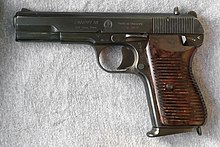
Hungary produced licensed copies of the TT-33 as the Pisztoly 48 Minta commonly referred to as the M48 or 48M,[9] as well as an export version for Egypt known as the Tokagypt 58 chambered for the 9×19mm Parabellum round which was widely used by police forces there.[6] Tokagypts differ from the M48 by an external thumb safety, an ergonomic wraparound grip, and a magazine with a finger rest.[10]
Egypt, however, cancelled its order after less than half of the 30,000 pistols ordered were delivered.[b] The remaining pistols were sold commercially by FÉG.[11]
North Korea
North Korea manufactured them as the Type 68 or M68.[6]
Pakistan
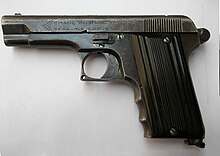
Both legal and illegal TT pistols are still manufactured in various Pakistani Khyber Pass factories.[12]
Poland
Poland produced their own copies as the PW wz.33, manufactured from 1947 to 1959.[6] In mid-50s a training version of PW wz. 33 was created, chambered in .22lr called TT Sportowy. All of those pistols were converted between 1954 and 1958 from the 7.62mm variant by changing the barrel and removing the locking lugs from slide.
Additionally, the Radom M48 was created in Radom, Poland as another slightly modified copy of the TT33.
Romania
Romania produced a TT-33 copy as the TTC, or Tokarev Cugir well into the 1950s. These have been made available for commercial sale in great numbers in recent years. However, to be importable into the United States, a trigger blocking safety was added.[13]
Vietnam
The K54 is a copy of the TT-33.[
The industry name for the regular K54 and the K14-VN is known as SN7M and the SN7TD.[17]
Yugoslavia / Serbia

Zastava produces an improved version of the TT-33 designated M57.[18]
The M57 has a longer grip and longer 9-round magazine (versus 8 rounds in TT).
Zastava manufactures a sub compact pistol M70 (a.k.a. Pčelica ("little bee")) roughly based on TT design in 7,65mm Browning (.32 ACP) or 9mm Kratak (.380 ACP). [citation needed]
Prior to 2012, the M57A, M70A and M88A were formerly imported into the U.S. by Century International Arms, but have since been replaced by Zastava USA.[20][21]
Conflicts
Users

 Albania:[30][2]
Albania:[30][2] Algeria[30][2]
Algeria[30][2] Angola[30][2]
Angola[30][2] Armenia[30]
Armenia[30] Azerbaijan[30]
Azerbaijan[30] Belarus: Used by reserve military units.[31][30]
Belarus: Used by reserve military units.[31][30] Benin[30][2]
Benin[30][2] Bosnia-Herzegovina[30]
Bosnia-Herzegovina[30] Bulgaria[30][2]
Bulgaria[30][2] Burundi: Burundian rebels[32]
Burundi: Burundian rebels[32] Cambodia[30][2]
Cambodia[30][2] Chad[30][2]
Chad[30][2] Red Guards during Cultural Revolution and People's Liberation Army Officers. Produced in large numbers as the Type 54.[33][2]
Red Guards during Cultural Revolution and People's Liberation Army Officers. Produced in large numbers as the Type 54.[33][2] Congo-Brazzaville[30][2]
Congo-Brazzaville[30][2] Croatia[30]
Croatia[30] pro-Russian separatists.[28]
pro-Russian separatists.[28] Egypt: Produced from the 1950s.[34]
Egypt: Produced from the 1950s.[34] Equatorial Guinea[30][2]
Equatorial Guinea[30][2] Georgia[30]
Georgia[30] Guinea[30][2]
Guinea[30][2] Guinea-Bissau[30][2]
Guinea-Bissau[30][2] Hungary: Produced locally.[22]
Hungary: Produced locally.[22] Indonesia[35]
Indonesia[35] Iraq[30][2]
Iraq[30][2] Ivory Coast[36]
Ivory Coast[36] Kazakhstan[37]
Kazakhstan[37] Kyrgyzstan[30]
Kyrgyzstan[30] Laos[30][2]
Laos[30][2] Libya[30][2]
Libya[30][2] Luhansk People's Republic Used by pro-Russian separatists. [38]
Luhansk People's Republic Used by pro-Russian separatists. [38] Madagascar[30][2]
Madagascar[30][2] Mali: People's Movement for the Liberation of Azawad[39]
Mali: People's Movement for the Liberation of Azawad[39] Malta[30][2]
Malta[30][2] Mauritania[30][2]
Mauritania[30][2] Moldova[30]
Moldova[30] Mongolia[30]
Mongolia[30] Montenegro[30]
Montenegro[30] Morocco[40]
Morocco[40] Mozambique[30][2]
Mozambique[30][2] North Korea: Produced locally as the Type 68.[41]
North Korea: Produced locally as the Type 68.[41] Pakistan: TT pistols are manufactured in various Pakistani Khyber Pass factories.[42]
Pakistan: TT pistols are manufactured in various Pakistani Khyber Pass factories.[42] Poland: Produced locally in the FB Radom arms factory.[22]
Poland: Produced locally in the FB Radom arms factory.[22] Romania: Produced locally at the Cugir factory under the designation "TTC".[30][2]
Romania: Produced locally at the Cugir factory under the designation "TTC".[30][2] Russian Federation[30][2]
Russian Federation[30][2] Serbia[30]
Serbia[30] Sierra Leone[30][2]
Sierra Leone[30][2] Somalia[30][2]
Somalia[30][2] Sri Lanka[43][2]
Sri Lanka[43][2] Syria[30][2]
Syria[30][2] Ukraine[29]
Ukraine[29] Uganda[30][2]
Uganda[30][2] Vietnam[30][2]
Vietnam[30][2] Zambia[30][2]
Zambia[30][2] Zimbabwe[30][2]
Zimbabwe[30][2]
Former users
 Islamic Republic of Afghanistan[30]
Islamic Republic of Afghanistan[30] Finland: Captured TT-33 pistols were carried by Finnish soldiers during the Winter War (1939–1940) and Continuation War (1941–1944) with the USSR. It was nicknamed the "Star Pistol" (tähti-pistooli)[22] due to the large Red Army star embossed on the grip panels. Although large numbers were acquired, the Finnish military never produced ammunition or spares for them because they were in a non-standard caliber.[22]
Finland: Captured TT-33 pistols were carried by Finnish soldiers during the Winter War (1939–1940) and Continuation War (1941–1944) with the USSR. It was nicknamed the "Star Pistol" (tähti-pistooli)[22] due to the large Red Army star embossed on the grip panels. Although large numbers were acquired, the Finnish military never produced ammunition or spares for them because they were in a non-standard caliber.[22] East Germany[30]
East Germany[30] Nazi Germany: Captured from the Soviet Union.[6]
Nazi Germany: Captured from the Soviet Union.[6] Soviet Union[33]
Soviet Union[33] Yugoslavia[33][44]
Yugoslavia[33][44]
See also
- List of Russian weaponry
- Table of handgun and rifle cartridges
Notes
- ^ Russian: 7,62-мм самозарядный пистолет Токарева образца 1930 года, romanized: 7,62 mm Samozaryadny Pistolet Tokareva obraztsa 1930 goda, "7.62 mm Tokarev self-loading pistol model 1930", TT stands for Tula-Tokarev)
- ^ Between 13,000 and 14,000 pistols according to Thompson, while George Layman gives a total of 13,250 pistols. (Thompson 2022, p. 64)
Bibliography
- Thompson, Leroy (2022). Soviet Pistols: Tokarev, Makarov, Stechkin and others. Bloomsbury Publishing. ISBN 978-1-4728-5349-3.
References
- ^ Monetchikov, S. (December 2007). "АРСЕНАЛ: ТТ: МАЛЕНЬКОЕ РУССКОЕ ЧУДО" [TT: Small Russian miracle]. "Bratishka" magazine. Archived from the original on 15 January 2015.
- ^ ISBN 0-7106-1548-5.
- ^ a b Cruffler.com (March 2001). "Polish M48 (Tokarev TT-33) Pistols". Archived from the original on 2008-01-31. Retrieved 2008-01-29.
- ^ Tokarev, Vladimir (2000). "Fedor V. Tokarev". Archived from the original on 2008-01-31. Retrieved 2008-01-29.
- ^ Henrotin, Gerard (2002). Soviet Military Pistols - Tokarev & Makarov. p. 9.
- ^ ISBN 978-1-84013-910-5.
- ^ PSM Shooting: 5.45x18mm vs 7.62x25mm on Soft Armor. Forgotten Weapons. July 1, 2017. Archived from the original on July 13, 2023. Retrieved June 6, 2023 – via YouTube.
{{cite AV media}}: CS1 maint: bot: original URL status unknown (link) - ISBN 978-1-58160-122-0.
- ^ Thompson 2022, pp. 62−63.
- ^ Thompson 2022, p. 64.
- ^ Thompson 2022, pp. 63−64.
- ^ "The Way of the Gun: The legendary gunsmiths of Darra Adam Khel". Riaz Ahmed. Express Tribune. 4 November 2012. Archived from the original on 2016-11-16. Retrieved 2016-11-16.
- ISBN 9781941998267.
- ^ "Sức mạnh dàn súng Việt Nam tự sản xuất". baodatviet.vn. Archived from the original on 7 December 2017. Retrieved 1 April 2018.
- ^ "Sức mạnh dàn súng Việt Nam tự sản xuất". baodatviet.vn. Archived from the original on 7 December 2017. Retrieved 1 April 2018.
- ^ "Súng ngắn K14 Việt Nam được phát triển thế nào?". 18 March 2015. Archived from the original on 2016-11-04. Retrieved 2016-11-03.
- ^ "[Indo Defense 2018] Vietnamese Small Arms Part Two: Grenade Launcher's, Galil ACE's, and OSV-96's -The Firearm Blog". 29 November 2018. Archived from the original on 2018-12-01. Retrieved 2018-12-01.
- ^ Thompson 2022, p. 66.
- ^ Thompson 2022, pp. 65−67.
- ^ "BREAKING: Zastava Arms USA to Become the Exclusive Zastava Firearms Importer -The Firearm Blog". 2 January 2019. Archived from the original on 2019-04-20. Retrieved 2019-03-19.
- ^ "PAPs, Toks and Mausers for the masses: Zastava launches U.S-based operation". Archived from the original on 2019-04-20. Retrieved 2019-03-19.
- ^ a b c d e f "FINNISH ARMY 1918 - 1945: REVOLVERS & PISTOLS PART 2". www.jaegerplatoon.net. Archived from the original on 23 April 2018. Retrieved 1 April 2018.
- ISBN 978-0-275-97835-8. Archivedfrom the original on 2018-12-09. Retrieved 2018-12-07.
- ISBN 9780850458008.
- ^ "Arms for freedom". 29 December 2017. Archived from the original on April 7, 2018. Retrieved 2019-08-31.
- ISBN 9781846030796.
- ISBN 978-0-521-19714-4. Archived from the original(PDF) on 2018-08-31. Retrieved 2018-08-30.
- ^ a b Ferguson, Jonathan; Jenzen-Jones, N.R. (2014). "Raising Red Flags: An Examination of Arms & Munitions in the Ongoing Conflict in Ukraine. (Research Report No. 3)" (PDF). ARES. p. 86. Retrieved 28 May 2020.
- ^ a b "Vintage Weapons In a Modern War: The TT-33 Pistol In Ukraine". The Armourer's Bench. Beaverton. 26 March 2023. Archived from the original on 19 October 2023. Retrieved 16 December 2023.
- ^ ISBN 978-0-7106-2869-5.
- ^ "It Became Known What the belarusian Territorial Defense is Armed With, Which the Wagnerians Will Train | Defense Express". en.defence-ua.com. Retrieved 17 July 2023.
- ISBN 978-0-521-88039-8. Archivedfrom the original on 2018-08-27. Retrieved 2018-08-29.
- ^ ISBN 1-930983-14-X.
- ISBN 0-00-712760-X.
- ^ "40 Prajurit Korem Bhaskara Jaya Diminta Tingkatkan Kemampuan Menembak". timesindonesia.co.id (in Indonesian). 17 March 2020. Retrieved 10 November 2021.
- ISBN 978-2-940-548-05-7. Archived from the original(PDF) on 2018-10-09. Retrieved 2018-09-05.
- ISBN 978-0-521-19714-4. Archived from the original(PDF) on 2018-08-31. Retrieved 2018-08-30.
- ^ "Vintage Weapons in a Modern War: The TT-33 Pistol in Ukraine". 26 March 2023.
- ISBN 978-0-19-928085-8. Archived from the original(PDF) on 2018-08-30. Retrieved 2018-08-29.
- ^ "Weapon". Archived from the original on 21 December 2014. Retrieved 14 November 2014.
- ^ "Archived copy" (PDF). Archived (PDF) from the original on 2016-03-04. Retrieved 2015-04-04.
{{cite web}}: CS1 maint: archived copy as title (link) - ^ //silahreport.com/2017/12/31/tokarev-7-62-x-25-local-made/
- ^ Smith, Chris (October 2003). In the Shadow of a Cease-fire: The Impacts of Small Arms Availability and Misuse in Sri Lanka (PDF). Small Arms Survey. Archived from the original (PDF) on 2017-07-05. Retrieved 2017-11-07.
- ^ "Modern Firearms". 23 October 2010. Archived from the original on 1 December 2014. Retrieved 14 November 2014.
